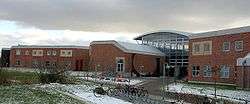Aalborg
Aalborg (/ˈɔːlbɔːrɡ/, also US: /ˈɑːl-, ˈɔːlbɔːr/,[3][4][5][6] Danish: [ˈʌlˌpɒˀ] (![]()
Aalborg Ålborg | |
|---|---|
City | |
View of Downtown Aalborg | |
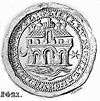 Seal 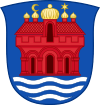 Coat of arms | |
| Nicknames: "Paris of the North",[1] locally "Double A" | |
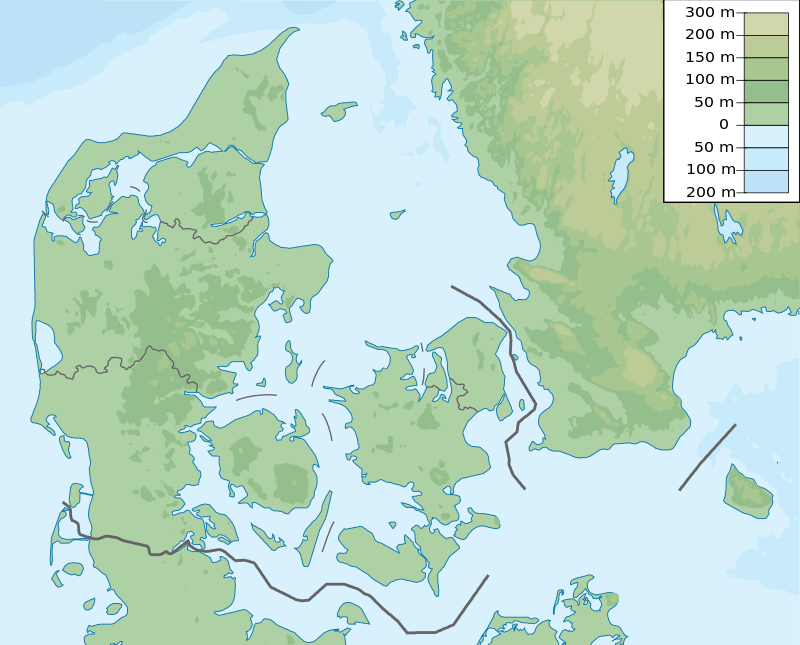 Aalborg Location within Denmark 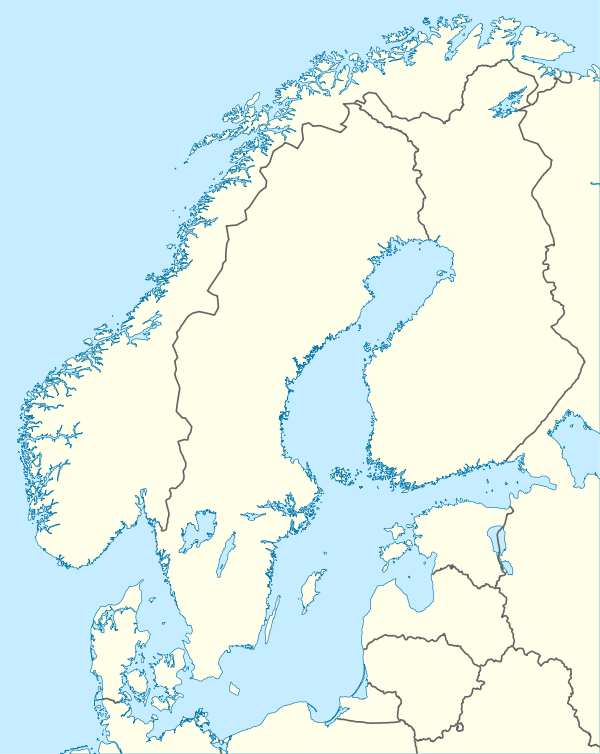 Aalborg Location within Scandinavia 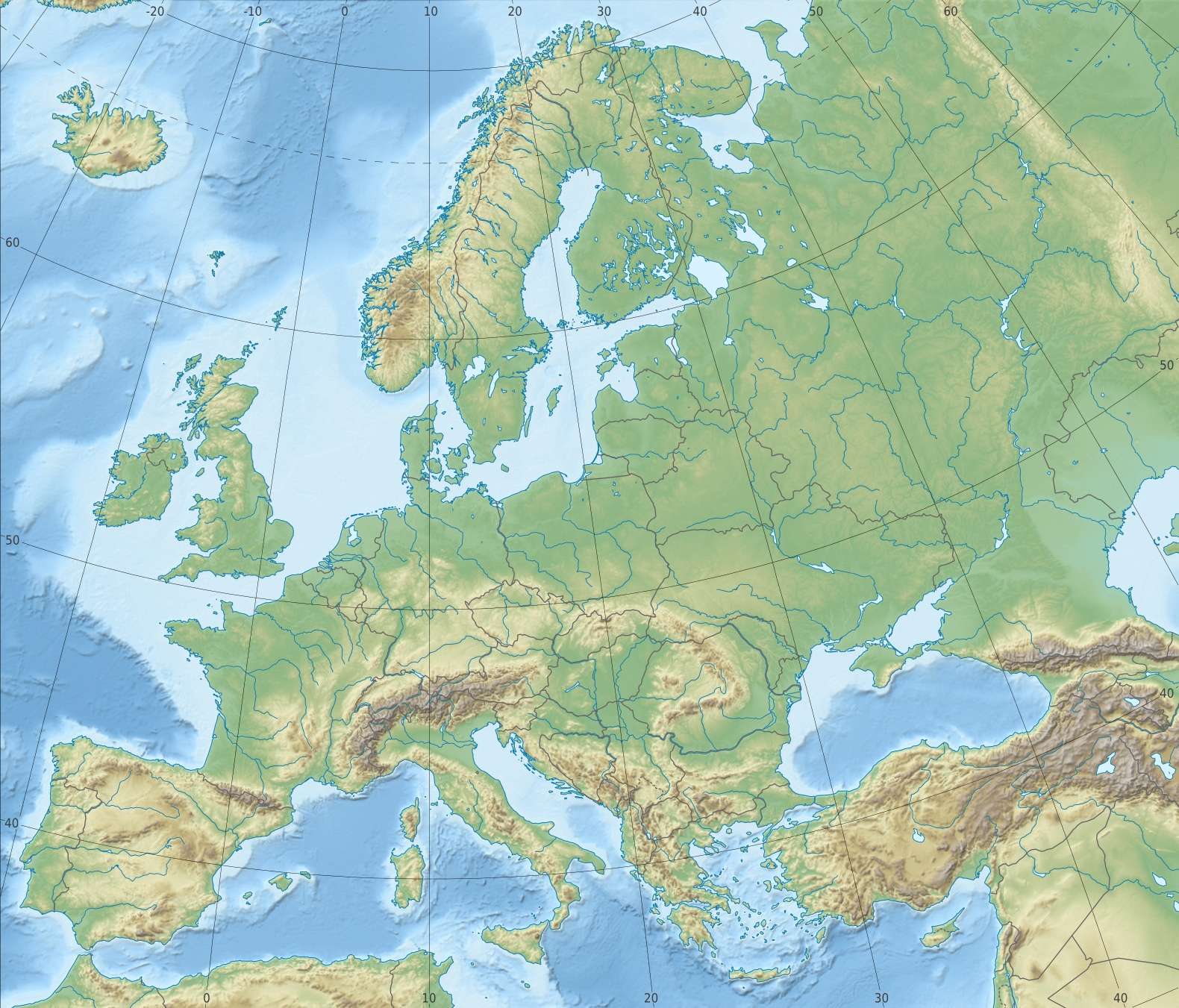 Aalborg Location within Europe | |
| Coordinates: 57°03′N 09°55′E | |
| Country | Denmark |
| Region | |
| Municipality | Aalborg |
| First mention | "Alabu" written on coins c. 1035 |
| Official establishment | 16 June 1342 |
| Government | |
| • Mayor | Thomas Kastrup-Larsen (S) |
| Area | |
| • Urban | 60.8 km2 (23.5 sq mi) |
| • Municipal | 1,144 km2 (442 sq mi) |
| Elevation | 5 m (16 ft) |
| Population (1 January 2020) | |
| • Urban | 140,897 |
| • Urban density | 2,300/km2 (6,000/sq mi) |
| • Municipal | 217,075 |
| • Municipal density | 178/km2 (460/sq mi) |
| • Demonym | Aalborgenser |
| Time zone | UTC+1 (Central Europe Time) |
| • Summer (DST) | UTC+2 |
| Postal codes | 9000, 9008, 9020, 9100, 9200, 9210, 9220, 9400 |
| Area code(s) | (+45) 9 |
| Website | www |
The twin city Nørresundby is 600 metres (2,000 ft) across the Limfjord. With a population of 217,075 (as of 2019), the Municipality of Aalborg is the third most populous in the country after Copenhagen and Aarhus.[7] By road Aalborg is 64 kilometres (40 mi) southwest of Frederikshavn, and 118 kilometres (73 mi) north of Aarhus. The distance to Copenhagen is 412 kilometres (256 mi) if travelling by road and not using ferries.
The earliest settlements date to around AD 700. Aalborg's position at the narrowest point on the Limfjord made it an important harbour during the Middle Ages, and later a large industrial centre. Architecturally, the city is known for its half-timbered mansions built by its prosperous merchants. Budolfi Church, now a cathedral, dates from the end of the 14th century and Aalborghus Castle, a royal residence, was built in 1550. Today, Aalborg is a city in transition from a working-class industrial area to a knowledge-based community. A major exporter of grain, cement, and spirits, its thriving business interests include Siemens Wind Power, Aalborg Industries, and Aalborg Portland. These companies have become global producers of wind turbine rotors, marine boilers and cement.
With its theatres, symphony orchestra, opera company, performance venues, and museums such as Aalborg Historical Museum and the Aalborg Museum of Modern Art, Aalborg is an important cultural hub. The Aalborg Carnival, held at the end of May, is one of the largest festivals in Scandinavia, attracting some 100,000+ people annually. The major university is the University of Aalborg, founded in 1974, which has more than 20,000 students (as of 2018).[8] The University College of Northern Denmark is one of seven new regional organisations while the Royal School of Library and Information Science (RSLIS) provides higher education in library and information science. Trænregimentet, the Danish regiment for army supply and emergency medical personnel, is also in Aalborg. Aalborg University Hospital, the largest in the north of Jutland, was founded in 1881.
The football club Aalborg BK, established in 1885 and based at Nordjyske Arena, won the Danish Superliga in the 1994–95 season, the 1998–99 season, the 2007–08 season and the 2013–14 season. Other sports associations include the icehockey club Aalborg Pirates, the men's handball team Aalborg Håndbold, the rugby club Aalborg RK, and Aalborg Cricket Club. Aalborg Railway Station, on John F. Kennedys Plads has connected the city to Randers and the south since 1869. Aalborg Airport is just 6 kilometres (3.7 mi) northwest of the city centre, and the E45, a European route from Alta, Norway, to Gela, Italy, passes through Aalborg.
The European Commission has concluded that the citizens of Aalborg are the most satisfied people in Europe with their city.[9]
History
The area around the narrowest point on the Limfjord attracted settlements as far back as the Iron Age leading to a thriving Viking community until around the year 1000 in what has now become Aalborg. In the Middle Ages, royal trading privileges, a natural harbour and a thriving herring fishing industry contributed to the town's growth. Despite the difficulties it experienced over the centuries, the city began to prosper once again towards the end of the 19th century when a bridge was built over Limfjord and the railway arrived. Aalborg's initial growth relied on heavy industry but its current development focuses on culture and education.[10]
Beginnings

Aalborg traces its history back over a thousand years. It was originally settled as a trading post because of its position on the Limfjord. The sites of what were two settlements and a burial ground can be seen on Lindholm Høje, a hill overlooking the city. These large settlements, one from the 6th-century Germanic Iron Age, the other from the Viking Age in the 9th to 11th centuries,[11] evolved at the narrowest point on Limfjord as a result of the traffic between Himmerland to the south and Vendsyssel to the north.
The first mention of Aalborg under its original name Alabu or Alabur is found on coins from c. 1040, the period when King Harthacnut (Hardeknud) settled in the area. In c. 1075, Adam of Bremen reported that Alaburg, as he called it in German, was an important harbour for ships sailing to Norway.[12] In Valdemar's Danish Census Book from 1231 it was called Aleburgh, possibly meaning "the fort by the stream" as in Old Norse all meant a stream or current and bur or burgh a fort or a castle.[13] The Church of Our Lady in Aalborg was originally built in the early 12th century but was demolished during the Reformation.[14] Grey Friar Convent, on the east side of Østerå, was probably built around 1240; it was documented in 1268 when it was a Franciscan Convent of the Order of Friars Minor, but like many other Roman Catholic monasteries and convents was shut down in 1530 as a result of the Reformation.[14]
Middle Ages
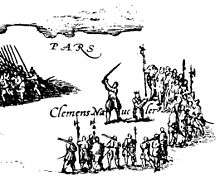
Aalborg's earliest trading privileges date from 1342, when King Valdemar IV received the town as part of his huge dowry on marrying Helvig of Schleswig. The privileges were extended by Eric of Pomerania in 1430 and by Christopher of Bavaria in 1441. The town prospered, becoming one of the largest communities in Denmark. Its prosperity increased when the merchant- and trade association Guds Legems Laug was established in 1481, facilitating trade with the Hanseatic League,[14] especially from 1516 when Christian II granted it a monopoly in salting Limfjord's herring.[15] The king frequently visited the town, where he held court and stayed in the old Aalborghus. The herring fishery linked Aalborg to the East coast of England, across the North Sea, both in commercial competition and cultural exchange.[11] During the Middle Ages a number of important institutions were established in Aalborg, including Budolfi Cathedral in the late 14th century and the Hospital of the Holy Ghost, a monastery and nunnery founded in 1451 to help those in need.[14] It was converted into a hospital during the Reformation and is still in use today as a nursing home for the elderly.[14]
In 1530 a large part of the town was destroyed by fire, and in December 1534 it was stormed and plundered by the king's troops after a peasants' revolt known as the Count's Feud led by Skipper Clement. It resulted in the death of up to 2,000 people.[14] The Reformation in 1536 brought about the demolition of the town's two monasteries.[11] As a result of the Reformation, Aalborg became a Lutheran bishopric in 1554.[14]
17th to 19th centuries
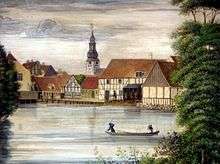
From the 1550s to the 1640s, as a result of increased foreign trade, Aalborg enjoyed great prosperity, second only to that of Copenhagen. The population grew in parallel with the development of many fine buildings in the city as merchants benefitted from their shipping routes from Norway to Portugal.[16] In 1663, the city suffered yet another serious fire, which destroyed the tower of Budolfi Church.[17]
During the second half of the 18th century, Aalborg entered a further period of prosperity. In Erik Pontoppidan's Danske Atlas (Danish Atlas) it was described as "after Copenhagen, the best and most prosperous market town in Denmark".[18] The population grew from 4,160 in 1769 to 5,579 in 1801. In 1767, the second newspaper ever published in Denmark appeared in the city.[10]
After Denmark ceded Norway to Sweden in 1814, Aalborg lost its important role as the country's centre for Norwegian trade. Its former prosperity also suffered as a result of difficulties with the herring industry as the fish disappeared after the sea breached the Agger Tange (which had linked Thy with the rest of Jutland at the western end of Limfjord) in the 1825 North Sea storm.[10] The after effects of the state bankruptcy in 1813 also contributed to widespread poverty in the city. In the mid-19th-century, Aalborg was overtaken by Aarhus as the largest city in Jutland. Towards the end of the 19th century there was however an upturn. In 1865, the pontoon bridge over Limfjord was completed, and in 1869, the railway reached the city with a railway bridge over the sound to Vendsyssel three years later.[11] The harbour facilities were also improved, making Aalborg Denmark's second port.[19] Aalborg became the country's main producer of tobacco products and spirits, followed in the 1890s by fertilisers and cement.[20] By 1901, the population had increased to almost 31,500.[10]
20th century industrialisation
Around the beginning of the 20th century, as a result of decisions taken by the municipality, many of the city's half-timbered houses were torn down. They were replaced by hundreds of modern buildings, completely changing the look of the city. Factories with smoking chimneys became ever more prevalent in the outskirts. Among the most important were De Danske Spritfabrikker (spirits and liquors), De forenede Textilfabrikker (textiles), the East Asiatic Company (trading), Dansk Eternit (building materials) and C.W. Obel's tobacco factory (established in 1787). Aalborg Portland, run by F.L. Smidth, was one of several cement factories operating in 1913, together employing some 800 workers.[19] By the 1930s, Aalborg was being promoted as "Denmark's new centre for industry and workers".[20] Replanning continued with additional thoroughfares cutting through the city. The port facilities were also improved with the help of a dredger and the opening of new docks. In 1933, Christian X inaugurated a new bridge over Limfjord to replace the fragile pontoon crossing.[11]
_(2).jpg)
Aalborg Airport, officially opened in 1938 because of the success of the cement industry, had in fact operated flights to Copenhagen since 1936.[21] During the German invasion of Denmark in 1940, the airport was captured by German paratroopers on the night of 21 April as a base for German aircraft flying to Norway.[22] On 13 August 1940, a dozen Bristol Blenheim bombers of No. 82 Squadron RAF were launched against the Luftwaffe airfield during one of the most disastrous Royal Air Force raids of the war. One turned back because of fuel problems, but all of the remaining 11 were shot down by enemy fighters and/or flak batteries within 20 minutes.[23][24] After the war, the Royal Air Force destroyed all the German facilities including planes, hangars and equipment but left the passenger facilities intact.[21]
By 1960, Aalborg had become known as the "city of smoking chimneys", with half of the inhabitants working in industry or manufacturing.[19] Ten years later, Aalborg's population had grown to around 97,000 inhabitants.[10]
Recent history
The significance of Aalborg's industry began to decline in the 1970s, precipitating a fall in the city's population until about 1990, when it began to increase again. By the year 2000, the service and education sectors accounted for about 60 percent of the workforce, partly as a result of the founding of Aalborg University in 1974. Since 1970, Aalborg and the northern suburb of Nørresundby have become a major administrative centre, thanks in part to the offices of the Region Nordjylland established in the east of the city.[19] In addition to large industrial companies including Aalborg Portland, the only cement-producing company in the country,[25] and the building products company Eternit, many small and medium-sized enterprises have been established. The telecommunications and information technology sector has developed with the support of Aalborg University and the North Jutland knowledge park NOVI.[26]
The First European Conference on Sustainable Cities and Towns took place in Aalborg in 1994. It adopted the Aalborg Charter, which provides a framework for the delivery of local sustainable development and calls on local authorities to engage in Local Agenda 21 processes.[27] The Fourth European Sustainable Cities and Towns Conference, held in Aalborg in 2004, adopted the more binding Aalborg Commitments on local sustainable development. The commitments have now been signed by 650 local authorities while over 2,500 have signed the earlier Aalborg Charter.[28]
Geography
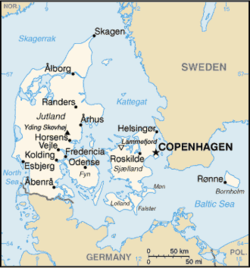
Aalborg is in North Jutland (northwestern Denmark), at the narrowest point of the Limfjord,[29] a shallow sound that separates North Jutlandic Island (Vendsyssel-Thy) from the rest of the Jutland Peninsula and connects Aalborg to the Kattegat about 35 kilometres (22 mi) to the east. Aalborg is 118 km (73 mi) north of Aarhus, 82 km (51 mi) north of Randers, and 64 km (40 mi) southwest of Frederikshavn.[30] It is 414 km (257 mi) by Great Belt Fixed Link to Copenhagen, 150 km (93 mi) by the Frederikshavn-Göteborg ferry to Gothenburg in Sweden, and 363 km (226 mi) by the Frederikshavn-Oslo ferry to Oslo in Norway.
The area close to the waterfront is low-lying, with an elevation averaging about 5 metres (16 ft),[30] but there are many hills in and around city, some reaching over 60 m (200 ft).[31] Nørresundby, on the northern side of the sound, is also a hilly area.[31] Villages to the south of Aalborg from west to east include Frejlev, Svenstrup, and Gistrup (which contains extensive woodland to the south as well as a golf club). Klarup and Storvorde lie to the southeast along the 595 road,[30] which, flanking a stretch of the Limfjord known as Langerak, leads to the town of Hals.[30] Nibe, with a harbour on the Limfjord, is 21 kilometres (13 mi) to the southwest, past the village of Frejlev. The Nibe Broads (Nibe Bredning) in the Limfjord not only has the largest eelgrass belts in Danish waters but is an important sanctuary for thousands of migratory birds.[32] To the north of the city, villages include Vadum, Aabybro, Vestbjerg, Sulsted, Tylstrup, Vodskov, and Hjallerup.[30] There is an extensive plantation, Branths Plantage - Møgelbjerg, immediately north of Vodskov.
The Himmerland region to the south still has a number of moors which once formed a vast area of heathland extending 35 km (22 mi) to the Rold Forest near Arden. Rebild Hills in the Rold Forest stretch over 425 acres (172 ha) of rolling heath country about 30 kilometres (19 mi) south of Aalborg.[33] Lille Vildmose, to the southeast, is reported to be the largest raised bog in north-western Europe.[34]
The city
The city centre, dating from the Middle Ages, lies on a series of clay banks between the former streams of Vesterå and Lilleå, which used to run into the sound. Despite effective drainage, the main streets, including Algade, still run east to west while the side streets run north to south. The Budolfi Church and the old town hall line Gammeltorv, the old market square. The main shopping streets are Algade and Bispengade, the latter lying inbetween the modern Vesterbro thoroughfare and Nytorv square. Østerågade, once the old harbor, is noted for its merchants' mansions.[26]
The city cemetery, the Kilden park and the modern art museum, Kunsten, are in the modern commercial and administrative area around the railway station to the west. Beyond this, Hasseris has become a residential district with a number of large villas and detached houses. The city's main development area is now to the east of the centre although in addition to the university and new areas of housing, it still contains the shipping harbor, Østhavnen, and the cement factory. The waterfront to the northeast of the centre is being transformed from a harbour into a recreational area with the Utzon Center and Musikkens Hus.[26]
Egholm
Off the northwestern side of the city in the sound is the island of Egholm, reached via ferry. The island, with a population of 55 as of 2013, covers an area of 6.05 square kilometres (2.34 sq mi) and consists mainly of farmland although there are still a few untilled areas of salt marshes and woodland. Dikes have been built along the coastline to protect the island from flooding.[35] The Kronborg Forest on the island, covering an area of 17 hectares (42 acres), was acquired by the municipal government in 1945.[35] A restaurant in the vicinity was established in 1918 but rebuilt in 1946 following a fire.[35] To the west of Egholm is the smaller uninhabited Fruensholm,[36] and there are also three small islands to the north.[30]
Lakes and chalk deposits
There are several man-made lakes nearby: Lindholm Kridtgrav lies to the northwest of Skanse Park on the northern side of Limfjord, while Nordens Kridtgrav to the northwest of Mølleparken is on the southern side.[30] The Aalborg area is one of three in Denmark where chalk deposits are found (the others being Møns Klint and Stevns).[37] The largest quarry is at Rørdal in Øster Sundby (6 km (4 mi) to the east of the city centre), while Vokslev (20 km (12 mi) to the west) has also provided chalk. Clay is also quarried in Østerådalen in the southern outskirts, making the area ideal for cement production.[38]
Parks and green spaces
The 6.5 hectares (16 acres) Østre Anlæg park is one of the oldest in Aalborg, visited by up to 175,000 people a year.[39] It was used as a dumping ground in the 1920s before being cleaned up and made into a recreational area in the 1930s and 1940s.[39] It contains lawns, flowers, tall trees, bushes, and a lake, overlooked by St. Mark's Church on the eastern side. Fifty-one species of bird have been recorded in the park.[39]
Lindholm Fjordpark, to the south of the Lindholm's industrial park, forms part of the green sector of the city known as 'Ryåkilen' along the coast of the sound, covering roughly 50 hectares (120 acres).[40] Like Østre Anlæg, it once served as a waste site with landfill, and a housing estate was built on its northeastern side.[40] Its use as a landfill site was gradually discontinued in the 1990s, and in 1996, extensive restoration work began.[40] Today it has woodlands and open areas with grass and herbaceous vegetation, notably buckthorn.[40] It is also a habitat for many species of migratory birds such as light-bellied brent geese, curlews, and songbirds. The park is also used by the Nordjysk Windsurfing Club and has a six-hole golf course.[40]
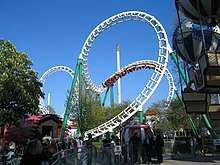
Aalborg has a number of additional civic parks and recreational facilities. Among them are Kildeparken, which hosts the annual Aalborg Carnival, Mølleparken, which contains a pond, statues, an outdoor exercise facility, and a 2.5 kilometre (1.6 mi) jogging trail (within the trail lies the Lysløjpen, a 45-metre [148 ft] gradient), Sohngårdsholmpark, a wooded area containing trails for both walking/jogging and biking and a six-hole golf course (free to the public), the Aalborg Open Air Swimming Pool, also free to the public, Bundgårdsparken, and Lindholm Strandpark.[41]
The Aalborg Zoo was opened in 1935 and typically houses 1,300 animals from 138 different species, including tigers, chimpanzees, zebra, elephants, giraffes, penguins and polar bears.[42] It is one of the area's major tourist attractions with over 300,000 visitors a year.[43] Within the zoo an African savannah has been created where exotic animals are housed.[34]
Aalborg was home to an amusement park, Karolinelund, founded in 1946. In 2005, still owned by the founding family, it was sold to an entrepreneur who resold it to the city the following year. When the park closed in 2010, it was home to 17 attractions. Recently, the city has reopened the park to volunteers who wish to return it to operating status. The park is once again open to the public as a leisure facility but without rides and attractions.[44] The association, Platform4, a non-profit user-driven project-oriented venue that experiments with technology (electronics) in combination with artistic genres is now located in the park. Volunteers frequently arrange seminars, exhibitions, films, music concerts, and more which are open to the public.
Climate
Aalborg has a maritime climate, just above the humid continental climate classification.
| Climate data for Aalborg (1971–2000) | |||||||||||||
|---|---|---|---|---|---|---|---|---|---|---|---|---|---|
| Month | Jan | Feb | Mar | Apr | May | Jun | Jul | Aug | Sep | Oct | Nov | Dec | Year |
| Record high °C (°F) | 10.5 (50.9) |
11.5 (52.7) |
18.8 (65.8) |
25.5 (77.9) |
27.5 (81.5) |
30.9 (87.6) |
32.1 (89.8) |
34.4 (93.9) |
25.8 (78.4) |
22.3 (72.1) |
15.2 (59.4) |
11.2 (52.2) |
34.4 (93.9) |
| Average high °C (°F) | 2.4 (36.3) |
2.6 (36.7) |
5.3 (41.5) |
10.0 (50.0) |
15.5 (59.9) |
18.6 (65.5) |
20.7 (69.3) |
20.4 (68.7) |
16.0 (60.8) |
11.5 (52.7) |
6.7 (44.1) |
3.7 (38.7) |
11.1 (52.0) |
| Daily mean °C (°F) | 0.2 (32.4) |
0.3 (32.5) |
2.3 (36.1) |
5.9 (42.6) |
10.9 (51.6) |
14.0 (57.2) |
16.0 (60.8) |
15.7 (60.3) |
12.2 (54.0) |
8.5 (47.3) |
4.2 (39.6) |
1.6 (34.9) |
7.6 (45.7) |
| Average low °C (°F) | −2.4 (27.7) |
−2.3 (27.9) |
−0.7 (30.7) |
1.9 (35.4) |
6.3 (43.3) |
9.8 (49.6) |
11.9 (53.4) |
11.4 (52.5) |
8.5 (47.3) |
5.1 (41.2) |
1.5 (34.7) |
−1 (30) |
4.2 (39.6) |
| Record low °C (°F) | −25.2 (−13.4) |
−19.4 (−2.9) |
−25.6 (−14.1) |
−8.1 (17.4) |
−2.1 (28.2) |
2.0 (35.6) |
4.2 (39.6) |
3.7 (38.7) |
−2.3 (27.9) |
−5.8 (21.6) |
−16.4 (2.5) |
−23.0 (−9.4) |
−25.6 (−14.1) |
| Average precipitation mm (inches) | 45.8 (1.80) |
29.6 (1.17) |
37.8 (1.49) |
30.8 (1.21) |
42.3 (1.67) |
55.5 (2.19) |
51.4 (2.02) |
58.1 (2.29) |
71.3 (2.81) |
66.4 (2.61) |
56.3 (2.22) |
52.8 (2.08) |
600.1 (23.63) |
| Average precipitation days (≥ 0.1 mm) | 16.5 | 12.8 | 14.9 | 11.5 | 11.1 | 12.0 | 11.5 | 12.6 | 15.3 | 16.2 | 17.7 | 17.3 | 169.3 |
| Average snowy days | 7.0 | 5.2 | 4.3 | 1.3 | 0.0 | 0.0 | 0.0 | 0.0 | 0.0 | 0.1 | 2.0 | 4.8 | 24.6 |
| Average relative humidity (%) | 89 | 87 | 84 | 76 | 73 | 75 | 74 | 76 | 80 | 84 | 87 | 89 | 81 |
| Source: Danish Meteorological Institute (humidity 1961–1990)[45][46] | |||||||||||||
Aalborg is cool most of the year, with average high temperatures of around 20 °C (68 °F) and lows of 11 °C (52 °F) during the summer,[47] and average temperatures of −3 to 2 °C (27 to 36 °F) during the coldest months of January and February, rarely dropping below −15 °C (5 °F). The warmest months are typically July and August, with an average temperature of 16 °C (61 °F), but by October the temperature averages 9 °C (48 °F).[48] June has the highest number of hours of sunshine on average at 218, closely followed by May and July.[48] Precipitation is rather evenly distributed all year around, with an average of 76 mm (3 in) during October, normally the wettest month with an average 14 days with rainfall, and an average of 35 mm (1 in) during February, normally the driest month with an average of eight days of precipitation, closely followed by April.[48]
Politics and government
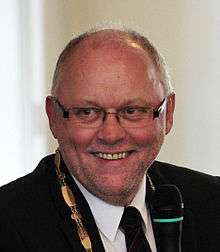
Henning G. Jensen, a Social Democrat, was the long-serving Mayor of Aalborg from 1998 until 2013.[49][50] He was succeeded by Thomas Kastrup-Larsen, also a Social Democrat, who was elected to the City Council in 1998.[51]
The civic government in Aalborg consists of seven departments:[52] the Mayor's Department (responsible for the titular position, the four Citizen Service Centres in Aalborg, the Financial Services division, the Commercial Services division, the General Services division, and the Fire and Rescue Centre);[53] the Technical and Environmental Department (responsible for urban planning, transportation oversight, the Parks and Nature division, and the Environmental Division);[54] the Department of Family and Employment (responsible for Children and Family services, social services, and the city's "Job Centre");[55] the Department of Care of the Elderly and Disabled (responsible for social benefits, senior citizen care, and disabled citizen care);[56] the Department of Education and Cultural Affairs (responsible for the municipal schools, the public libraries, the Cultural Affairs division, and the city archives);[57] the Health and Sustainable Development Department (responsible for public health, the Occupational Health and Safety Division, the Public Transportation division, and the Sustainable Development division);[58] and the Utilities Department (responsible for gas, heating, water, sewage, and refuse collection).[59]
Aalborg City Council consists of 31 members, including a mayor. As of September 2013, 11 of the council seats are held by the Social Democratic Party, nine by Venstre, three by the Socialist People's Party, two by the Danish People's Party, and two by the Conservative People's Party, while three members are professed independents.[60] The council is mandated to hold a minimum of two meetings per month, with meetings of a public forum format.[61]
Demographics
Aalborg was the largest city in Jutland until it was surpassed by Aarhus in the mid-19th century.[14] In 1672, it had 4,181 inhabitants, growing slowly during the 18th century, with 4,425 in 1769, 4,866 in 1787 and 5,579 by 1801.[62] By 1845, there were 7,477 inhabitants, increasing to 10,069 by 1860. Dramatic growth began in the late 19th century, with an increase from 14,152 in 1880 to 31,457 in 1901.[62] By 1930, the population had grown to 59,091, although the figure was boosted by the merging of Nørre Tranders, Rørdal Fabriksby, Øster Sundby and Øster Uttrup into Aalborg. In 1950, it reached 87,883, which grew to 100,587 by 1970.[62] There was a temporary decline in population to 94,994 in 1976 but in 1981, following the incorporation of Nørresundby, it grew to 114,302.[62] The population has increased steadily since then; according to the census of 1 January 2009, Aalborg had a total of 122,461 inhabitants,[63] 101,497 of them living in the city and 20,964 in the independent suburb of Nørresundby. As of 2015, the city has a total of 132,578 inhabitants (110,495 in the city proper and 22,083 in Nørresundby) [64] making it the fourth most populous in Denmark after Copenhagen, Aarhus and Odense.[65][63] Statistics for 2016 showed there were 210,316 people living in the Municipality of Aalborg.[7]
Economy
Aalborg is North Jutland's major industrial and commercial centre, exporting grain, cement, and spirits.[66] Heavy industry was behind the city's prosperity until fairly recently. Many of the factories have now closed, to be replaced by developments in the knowledge-based and green-energy sectors.[29] Mobile and wireless communications industries have grown substantially since the 1990s, as has rotor production for wind turbines.
In January 2011, there were some 9,200 enterprises in Aalborg, employing around 109,000 people or approximately 35% of the workforce of the Northern Region. In the 2010s, the city is set on increasing its participation in the global economy through both existing companies and new entrants. Its efforts are focused on four areas: energy and environment, information technology, health support systems and "Arctic business". The latter covers trade with Greenland as the Port of Aalborg handles over 60% of all goods shipped to Greenland. Four harbours dot the waterfront, Marina Fjordparken, Skudehavnen, Vestre Badehavn, and Østre Havn. Tourism is also growing, with a considerable rise in the number of passengers at Aalborg Airport. Aalborg Municipality has Denmark's second highest revenue from tourism and is the only municipality in the north of Denmark where overnight stays are increasing.[67][68]
Major private companies
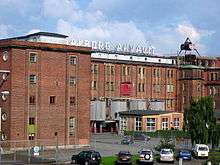
Telenor Denmark, part of the Norwegian Telenor telecommunications and mobile phone company, has a workforce of about 1,100 in Aalborg, making it one of the city's largest new employers.[69] Siemens Wind Power has rotor-blade production and testing facilities in Aaborg. In 2012 and 2013, there were additions in both areas. The new testing plant is the world's largest research test centre for wind turbine technology.[70][71] In 2012, the company shipped a record 570 wind turbine blades from the Port of Aalborg, mainly to England and Ireland, up 45% on the previous year.[72]
Aalborg was home to De Danske Spritfabrikker or Danish Distillers (now owned by the Norwegian company Arcus), which produces numerous brands of akvavit, until 2014.[73] The company is the world's largest akvavit producer and exporter.[74] Aalborg Industries, the world's largest manufacturer of marine boilers, has been established in Aalborg since the 1920s.[75] It has recently expanded into floating production systems for the offshore market. Employing 2,600 people, in December 2010 it was acquired by the Swedish Alfa Laval, also a specialist in the area.[76] Aalborg Portland, a subsidiary of the Italian Cementir since 2004,[77] was founded in 1889 with the support of FLSmidth. Able to draw on the chalk deposits from Rørdal to the east of the city, it rapidly became a major cement producer. Today it is the world's largest supplier of white cement, which it exports around the globe.[78]
Facilities
Aalborg has a wide selection of shops and restaurants. In the city centre, there are both large department stores and smaller speciality shops. One of the largest shopping malls in Denmark, the Aalborg Storcenter, is to the south of the city in Skalborg. It has about 75 stores, including a large Bilka supermarket.[79] The city has over 300 restaurants,[80] catering in Danish, European and Asian dishes. Notable establishments include Fusion on the waterfront,[81] Mortens Kro, run by celebrity chef Morten Nielsen, and Irish House, a pub in the 17th-century Jens Olufsen's House.[82] While Aalborg is renowned for its alcohol and nightlife,[80] there are also a number of coffee shops.[83]
Aalborg has 12 large hotels, most within walking distance of the city centre.[84] The Helnan Phønix Hotel is the largest, occupying what was originally built as a lavish private residence in 1783 for a Danish brigadier.[85] It was converted into a hotel in 1853, and in 2011 had 210 rooms, furnished with dark oak.[85] The Chagall was established in the 1950s and has reproductions of Marc Chagall paintings in the rooms.[85] Radisson Blu Limfjord Hotel, operated by the Radisson Hotels chain, contains 188 rooms and has the Italian restaurant Vero Gusto.[86] The Park Hotel, opposite the railway station, was established in 1917.[85] Other hotels include Cabinn Aalborg, Hotel Hvide Hus, Hotel Krogen and Prinsen Hotel. Several banks including Danske Bank, Forex, Jyske Bank, Spar Nord and Nordea have branches in Aalborg.[87]
Landmarks

.jpg)
Despite its industrial background and the factories along its waterfront, the city has gained popularity for tourism in recent years, offering a wide variety of attractions and historic buildings in addition to its museums, churches and parks.[88] See the religion section for details on churches.
Historic buildings
Jens Bang's House (Danish: Jens Bangs Stenhus), on Østerågade near the old town hall, is one of Denmark's best examples of 17th-century domestic architecture. Built in 1624 by the Aalborg merchant Jens Bang in the Dutch Renaissance style, the four-story sandstone building is noted for its rising gables and sculpted auricular window decorations. For over 300 years, it has housed the city's oldest pharmacy.[89]
Jørgen Olufsen's House (Jørgen Olufsens Gård) on Østerågade is Denmark's best preserved merchant's mansion in the Renaissance style. Built mainly of sandstone in 1616, it also has a half-timbered section. The style is reminiscent of similar buildings in the north of Germany and in the Netherlands. Olufsen, Jens Bang's half brother, was not only a successful merchant but also mayor of Aalborg. When it was built, the residence with its integrated warehouse was on the Østerå, an inlet from the sound with access for barges. The old iron bar with a hook for scales can be seen in the portico.[90][91]
Aalborghus Castle (Aalborghus Slot) is a half-timbered building with red-painted woodwork and whitewashed wall panels. It was built in the mid-16th century by King Christian III for his vassals who collected taxes and is the only remaining example of its kind in the country.[12] The park, dungeon and casemates, but not the castle itself, are open to the public in the summer months.[92] In the 1950s, the castle was converted into administrative offices.[10]
Aalborg's old city hall in Gammeltorv, in service until 1912, was built in 1762. It is now only used for ceremonial and representative purposes. Designed in the Late Baroque style, the building with its black-glazed tile roof consists of two storeys and a cellar. The yellow-washed façade is decorated with white pilasters and a frontispiece featuring the Danish coat of arms and a bust of King Frederick V. His motto, Prudentia et Constantia, is also seen above the main entrance.[93] The well-preserved door is an example of the Rococo style. The building was listed by the Danish Heritage Agency in 1918.[94]
Another old building of note is the half-timbered Håndværkerhuset (at Kattesunded 20) from c. 1625, which originally housed a number of warehouses. It is now used as a centre for arts and crafts.[95] Finally, the headquarters of Danish Distillers (De Danske Spritfabrikker), to the west of the Limfjord Bridge, is noted for its Neoclassical appearance. Completed in 1931 by the architect Alf Cock-Clausen, it combines functionality with decorative classical symbolism. Considered a masterpiece of Danish factory design, it is now a Danish National Heritage site.[11][96] When the factory closed in 2014, was the area bought by an investor, who will use the buildings to create an international culture city with museums, theatres, apartments etc.
Other landmarks
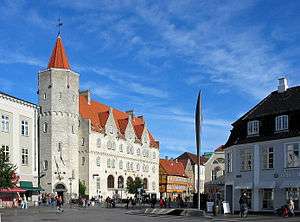
Jomfru Ane Gade (literally Virgin Anne's Street) is one of the most famous streets in Aalborg if not in Denmark. Popular for its cafés and restaurants during the day, it is even busier at night with its clubs, discos and bars. During the 1990s, the street was infamously a 'hang out' of two biker gangs who were at war for some years all over Scandinavia. As the bikers disappeared it became increasingly popular for people of all ages.[97][97] The pedestrian hubs of Nytorv Square and John F. Kennedy Square in the central city area are also part of the cityscape.
Aalborgtårnet is a tripod tower erected in 1933 with a restaurant on the top. The tower itself is 55 m (180 ft) high; but as it stands on the top of the Skovbakken hill, it reaches a total height of 105 m (344.49 ft) above sea level, providing a view over the sound and the city. Designed by Carlo Odgård, it was erected in 1933 in connection with the North Jutland Fair.[98]
In 2008, the Utzon Center, its art, architecture and design credited to the noted architect Jørn Utzon, is also dedicated to him.[34] It was built next to the Limfjord at the central harbour front in Aalborg. Born in Copenhagen, Utzon grew up in Aalborg. The centre contains an exhibition on Utzon's work, which includes the Sydney Opera House, as well as educational displays on architecture and design.[99] The centre consists of several individual buildings creating a special place around a courtyard on a platform. The tall sculptural roofs of the auditorium and the boat-hall, both on the harbour front, and the library facing the park area and the city are set off by the lower roofs of the exhibition and workshop areas inside the complex.[100]
Culture
The annual Aalborg Carnival usually takes place in the last weekend of May.[101] It consists of three events: the children's carnival (Børnekarneval),[102] the battle of carnival bands,[103] and the carnival proper. Attracting about 100,000 visitors, it is the biggest carnival in Scandinavia and one of the largest in northern Europe.[42] Hjallerup Market in Hjallerup, about 20 kilometres (12 mi) northeast of Aalborg is one of the oldest and largest markets in Denmark and is the largest horse market in Europe.[80] Held for three days in the beginning of June, it annually attracts more than 200,000 people and 1200 horses.[80]
In 1999 Aalborg was for the first time one of the four host ports in The Tall Ships Race (then Cutty Sark Tall Ships Race) of that year. The city hosted the world's largest event for sailing vessels again in 2004 and 2010, and will do so for the fourth time in less than two decades when The Tall Ships Races visits Aalborg in early August 2015.
Major venues
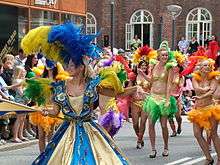
Aalborgs Kongres & Kultur Center, designed in a functional style by Otto Frankild, was completed in 1952. The centre's main component, the Aalborg Hall, can be divided into sections. The complex also contains a hotel, restaurant, bowling alley, and a number of meeting rooms. The smaller Europahallen was added in 1991, making the centre the largest in Scandinavia.[104] With over 100 theatrical and musical presentations per year, it offers international stars, opera, ballet, musicals, classical concerts, productions for children as well as pop and rock concerts. It can accommodate audiences of up to 2,500.[105] Aalborg Teater, built in 1878 and subsequently modified by Julius Petersen, seats 870 in the main auditorium. First privately owned, the theatre is now controlled and owned by the Danish Ministry of Culture. While most productions are housed in the main hall, the building can accommodate up to four shows at once in halls of varying sizes.[106] Over the years, the theatre has produced a wide selection of drama and musicals.[107]
Nordkraft is a cultural centre in a former power plant near the harbour. It has theatres, a cinema, and concert facilities. Kunsthal Nord, established in the centre in 2009, arranges up to five exhibitions a year of all forms of contemporary art, especially of local origin but also from other parts of Denmark and beyond. It serves as the exhibition centre for KunstVærket, the North Jutland centre for the arts, and also works in collaboration with the modern art museum Kunsten designed by the Finnish architect Alvar Aalto.[108][109]
In the same neighbourhood, a huge concert hall, Musikkens Hus, designed by Coop Himmelb(l)au, opened in 2014. It is Aalborg's most ambitious construction project in recent years.[110]
The city also has a wide selection of galleries and arts and crafts outlets operated by local artists. The Academy of Music also has a presence in Aarhus.[34] There are several glass workshops; others produce jewelry, sculptures or exhibit paintings.[111]
Museums
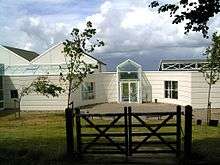

There are various museums in the city. The Aalborg Historical Museum was established in 1863, making it one of the earliest provincial museums in the country.[112][113] The North Jutland Historical Museum conducted a series of archaeological excavations in the 1950s at Lindholm Høje, revealing ancient burial sites. In 1992, the Lindholm Høje Museum was opened there and extended in 2008.[114] In 1994 and 1995, excavations at the site of the Greyfriars Monastery resulted in the creation of the underground Gråbrødrekloster Museum in the city centre.[115] Several organisations now collaborate under the leadership of the North Jutland Historical Museum.[116] The Springeren - Marine Experience Center is a marine museum on the city's wharf with a wide range of exhibits including "Springeren", an old Danish submarine, whence its name.[117][118] The Aalborg Defence and Garrison Museum documents Danish defences during the Second World War as well as the history of Aaborg's garrison since 1779.[119] The KUNSTEN Museum of Modern Art Aalborg was built from 1958 to 1972;[120] the collection consists of around 1,500 art objects, including paintings, sculptures and other media.[121]
Music
The Aalborg Symphony Orchestra (Aalborg Symfoniorkester) founded in 1943 presents about 150 concerts a year, frequently playing in the Musikkens Hus. It also plays for the Jutland opera company (Den Jyske Opera, also based in Aalborg), and at the Royal Danish Theatre in Copenhagen. It is one of the main organisers of the 10-day Aalborg Opera Festival held every March.[122][123] Aalborg has the jazz club Jazzclub Satchmo and an annual jazz and blues festival (Den Blå Festival), also known as the Mini New Orleans Festival. Over four days in mid-August, concerts are performed on squares, in the streets, and in cafés and restaurants.[124] Since 2012, the Egholm Festival, a small music festival on the island of Egholm near Aalborg has been organized in the first weekend of August.[125] It features relatively unknown upcoming pop, rock and hip-hop artists. The festival has two stage areas and was organized by the Musical Association Aalborg (MUSAM) and Aalborg Events.
Religion
Lutheranism
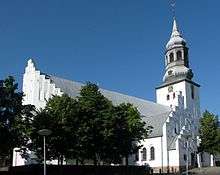
The principal religion in Aalborg as in the rest of Denmark is Christianity. Aalborg is the seat of a bishop within the Lutheran State Church of Denmark. The cathedral of this bishopric is the Budolfi Church, originally built no later than 1132 by Viborg's Bishop Eskil. This church was considerably smaller than the current one, as it was merely a parish church. The existing structure was completed in the late 14th century, on the grounds of the former church, and was listed for the first time in the Atlas of Denmark in 1399. The church was named after St Botolph, an English abbot and saint.[126] The church is constructed in the Gothic style.[126] In 1554 Aalborg was made a diocese and, after consideration, St Budolfi Church was made the seat of the Bishop of Aalborg. Aalborg is also home to the former Catholic church, the Abbey of Our Lady, converted from a Benedictine nunnery.[127]
Churches
The present Budolfi Church, which has the status of a cathedral, dates from the end of the 14th century, although at least two earlier churches stood on the same spot. Built in the Gothic style, it consists of a nave flanked by two aisles, a tower, and a porch. After the original tower was destroyed by fire in 1663, the striking new Baroque tower, based on that of an earlier Copenhagen city hall, was completed in 1779. The church has 16th-century frescoes and an intricately carved early Baroque altarpiece from 1689 created by Lauridtz Jensen.[128]
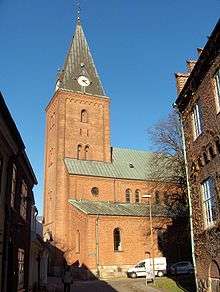
Abbey of Our Lady (Vor Frue Kirke) was designed in 1878 by J.E. Gnudtzmann in the Neo-Romanesque style. The original Church of Our Lady from the early 12th century was pulled down after the Reformation because it was old and unstable, but the 12th-century tower and the original portal with sculpted decorations can still be seen. The carved pulpit dates to around 1581.[11][129]
As a result of the considerable population increase from the end of the 19th century, a number of new churches were built in various styles. Next to Aalborg Hall, Ansgar's Church with its tall tower was built in 1929 to a design by Hother August Paludan in a modern Baroque style.[130] St Mark's Church (Sankt Markus Kirke), completed in 1933, was designed by Einar Packness. Its tower is crowned by an imposing spire. The Biblical figures known as the Johannes Group (based on Christ's meeting with John the Baptist in Matthew, Chapter 3) sculpted by Bertel Thorvaldsen are displayed around the interior.[11][131] The Margrethe Church with its steeply sloping roof reaching 22 m (72 ft) is the work of Carlo Odgaard and Aaby Sørensen. Bent Exner designed some of the artefacts in the church including the crucifix over the altar.[132]
Cemeteries
Aalborg's cemeteries have a history dating to the end of the Middle Ages. Sankt Jørgens Kirkegård (St George's Cemetery) was on the corner of Hasserisgade and Kirkegårdsgade. The site was chosen in a district outside the city as it provided isolation for those affected by the plague, many of whom died in the neighbouring hospice, Sankt Jørgens Gårde. In 1794, a new cemetery was opened in Klostermarken, immediately to the south of Sankt Jørgens Kirkegård. It was further extended in 1804, 1820 and 1870. It is now known as Aalborgs Almen Kirkegård (meaning "common cemetery") and contains the graves of many of the city's most notable citizens.[133]
Judaism
Aalborg had a synagogue, built in 1854; and the Jewish rabbi Salomon Mielziner served it for 35 years.[134] Services were no longer offered after Mielziner died, and in 1924 the synagogue was donated to the city government, which began using it to store the city archives (Stadsarkivet).[134] It was burned down by the Schalburg Corps in April 1945 towards the end of World War II, destroying its centuries-old Torahs.[134][135] Anti-semitism continues to exist in Denmark, and in 1999, an unlicensed Nazi radio station began operating from a neo-Nazi stronghold in Fynen, Nørresundby, within Aalborg municipality.[136] The activity has been widely denounced with organized opposition in Aalborg and the rest of Denmark, and in February 1999, 12 anti-fascists were arrested for possession of explosives at their base in Fynen.[136]
Education
The major university in Aalborg is the University of Aalborg, founded in 1974.[137] It has more than 17,000 students and more than 3,000 employees.[138] In 2012, 3,000 new students started at the university. In 1995 it merged with Esbjerg Engineering College.[137] The university has attempted from the outset to "develop a more "relevant" form of education than was then being offered by the established universities".[139] It has sought to develop what is known as "contextual knowledge", a form of problem-based learning based around the project work conducted by students, rather than the curriculum focusing on traditional academic disciplines.[139]
The University College of Northern Denmark is one of seven new regional organisations (professionshøjskoler) of different study sites in Denmark offering courses normally at the bachelor level. The Royal School of Library and Information Science (RSLIS) provides higher education in library and information science; one of its two departments is in Aalborg. With about 4,500 students a year and 700 employees, Tech College Aalborg offers a wide spectrum of vocational training and runs Aalborg Tekniske Gymnasium. Aalborg Business College provides basic training in retail and trading for private enterprises and the public sector, with courses which cover information technology, economics, sales and communication, and languages.[140]
The island of Egholm contains the former Egholm Skole, which was closed in 1972 when a ferry service to Aalborg was established and children on the island began attending the Vesterkæret Skole in Aalborg. Today the old school on Egholm is run as a school camp by the City of Aalborg, with 18 beds and facilities for 60 people.[35] Skipper Clement International School is a private school for children between 6 and 16. The international department conducts its classes in English, the first to be established in the Jutland peninsula,[141] but it does have department which educates in Danish, like the public schools in Denmark.
Sport
The city is home to Aalborg BK, established in 1885 and known as "AaB" for short. The club has won the Danish championship (Superliga) four times in recent years (1995, 1999, 2008, 2014). The team qualified for the group stages of the 1995–96 and 2008–09 UEFA Champions League seasons. Aalborg Chang is a Danish amateur association football club, previously known as FC Nordjylland.
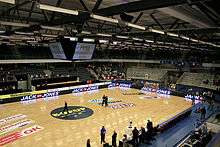
Aalborg is also known for the women's handball club Aalborg DH, and the men's handball club Aalborg Håndbold. Established in 2001 and 2011, respectively, they both play their games in the Gigantium.[142] Rugby in Aalborg is represented by Aalborg RK Lynet (Lightning), established in 1964. The city also has the Aalborg Cricket Club, which is part of the Danish Cricket League.[143] They were established in 2000 and have players from various nations.[144][145]
Aalborg Tennisklub is located along the Kastetvej road in the centre of Aalborg. About 10 kilometres (6.2 mi) to the southwest of the city, near the hamlet of Restrup Enge, is Aalborg Golf Klub.[146] Aalborg Golf Klub is the second oldest golf club in Denmark, and was originally established in 1908 in the eastern part of Aalborg. In 1929 it moved to Sohngaardsholm, but 30 years later the course had to again move because of developments with the university.[147] The present course to the southwest of Aalborg was designed in 1968 by Graham Lockey and Commander John Harris as a 9-hole course, later expanded to 18 holes in 1976 and 27 in 2006.[147] In 2010 the club hosted the European Girls Team Golf Championships.[147] Another course, Ørnehoj Golfklub, is at the southeastern limits of the city, in the village of Gistrup.[148]
On 11 September 1977, Aalborg hosted the Final of the Long Track World Championship for Motorcycle speedway. The Final was won by Swedish rider Anders Michanek. He defeated West Germany's Hans Seigl and Denmark's own speedway hero Ole Olsen.
Transport
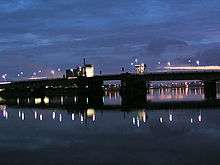
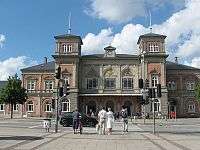
On the north side of the Limfjord is Nørresundby, connected to Aalborg by the Limfjordsbroen road bridge, which was inaugurated in 1933, replacing a pontoon bridge which dated to 1865. The iron Limfjord Railway Bridge, inaugurated in 1938, is a nine-span bascule bridge. It opens 4,000 times a year, allowing around 10,000 vessels to sail under it.[149] Opening in 1969 as the first motorway tunnel to be built in Denmark,[150] the Limfjord Tunnel[151] is 582 m (1,909 ft) long and has three lanes in each direction. It forms part of the E45, stretching from Alta, Norway, to Gela, Italy.[152]
Aalborg Airport is 6 kilometres (3.7 mi) northwest of the city centre. With its two runways, it has 20 direct routes to destinations in Denmark, Norway, Ireland,[153] the Netherlands, the UK, Spain, and Turkey, along with seasonal flights to additional Spanish destinations and the Faroe Islands. Processing 1.4 million passengers a year, the airport is the third largest in Denmark.[154] The Aalborg Air Base, an important Danish Air Force facility, occupies part of the extensive airport area.[155] The Port of Aalborg is northern Denmark’s main import/export hub,[156] operated by Aalborg Havn A/S on the Limfjord. Two additional private harbours serve the cement factory, Aalborg Portland A/S, and the power station, Vattenfall A/S.[157]

The city's main train station, Aalborg Railway Station, is on John F. Kennedys Plads. It opened in 1869, when the Aalborg to Randers railway was inaugurated. The original station building was designed by N.P.C. Holsøe while the present building, which opened in 1902, was designed by Thomas Arboe. Aalborg Railway Station is operated by Banedanmark and DSB.[158] Other rail stations in Aalborg are Skalborg Station, Aalborg Vestby Station and Lindholm Station. There are regular bus services covering the inner city as well as the wider urban area.[159]
Cycling is also relatively popular in Aalborg. Statistics for 2012 indicate 44% of the population use their bicycles several times a week while 27% of the workforce cycle to work. The municipal authorities hope to increase the use of bicycles by providing better cycle tracks and parking facilities, as well as improved support services.[160] City bikes are provided free of charge in Aalborg and Nørresundby from April to November with numerous stands throughout the area.[161]
Healthcare
Aalborg University Hospital, the largest in the north of Jutland, was founded in 1881. As of 2013, it consists of two large buildings in Aalborg, the hospital in Dronninglund and smaller departments in Hobro and Hjørring. It is the largest employer in the area with around 6,500 on the payroll.[162] The hospital has traditionally undertaken research but from the beginning of 2013 it has had a formal collaboration with Aalborg University.[163] A new building, designed by schmidt hammer lassen architects and to be completed by 2020, will provide 134,000 m2 (1,440,000 sq ft) for hospital buildings and 17,000 m2 (180,000 sq ft) for the university's Faculty of Health.[164] The Aalborg University Hospital, section south, is on Hobrovej and has a 24-hour emergency ward.[29] The northern section is in Reberbanegade, which is in the western part of the city centre. Trænregimentet, the Danish regiment for army supply and emergency medical personnel, is also in Aalborg.[165]
Media
Nordjyske Stiftstidende, published in Aalborg, is Denmark's second oldest newspaper founded in 1767 as Nyttige og fornøyelige Jydske Efterretninger. It was later known as Aalborg Stiftstidende (until 1999). In 1827, it merged with Aalborg's second newspaper Aalborgs Stifts Adresse-Avis. The paper now serves the whole of Vendsyssel and most of Himmerland and has local editions in Aalborg, Hjørring, Hobro, Frederikshavn, Fjerritslev, and Skagen and Brønderslev.[166]
ANR (also Aalborg Nærradio and Alle Nordjyders Radio) is a local radio station operated by Nordjyske Medier, owner of Nordjyske Stiftstidende. The TV news channel, 24Nordjyske, is operated by the same firm.[167]
International relations
Twin towns – sister cities
Aalborg maintains cultural, economic and educational ties with 34 cities around the globe,[168][169] more than any other city in Denmark.[170] Every four years Aalborg gathers young people from most of its twin cities for a week of sports, known as Ungdomslegene (Youth Games).[170]
Notable people
Among those who contributed to Aalborg's prosperity in the 19th century were Poul Pagh (1796–1870) who significantly developed trade and shipping, and Christen Winther Obel (1800-1860) who increased production at the C.W. Obel tobacco factory until it became the city's main employer. Another important figure of the times was Marie Rée (1835-1900) who ran the local newspaper Aalborg Stiftstidende until 1900, often promoting women's rights.[172]
More recently, the actor and script-writer Preben Kaas (1930–1981), who was born in Aalborg, starred in over 50 Danish films.[173] Among the city's many sporting figures, Peter Gade (born 1976) stands out as one of the world's most successful badminton players.[174]
On the cultural side, Jørn Utzon (1918–2008), designer of the Sydney Opera House, grew up in Aalborg; the iconic Utzon Center which he inspired now serves as a museum for his architectural designs and offers courses of study based on his approach.[175]
References
Footnotes
- According to Retskrivningsordbogen § 3.2, both are correct.[176]
Notes
- "ELSA Aalborg". studyvisits.elsa.org. Retrieved 27 February 2020.
- "Statistik om Folketal 2009" (in Danish). Aalborg Municipality. Retrieved 17 August 2013.
- "Ålborg". The American Heritage Dictionary of the English Language (5th ed.). Boston: Houghton Mifflin Harcourt. Retrieved 16 April 2019.
- "Aalborg". Collins English Dictionary. HarperCollins. Retrieved 16 April 2019.
- "Aalborg" (US) and "Aalborg". Oxford Dictionaries UK Dictionary. Oxford University Press. Retrieved 16 April 2019.
- "Ålborg". Merriam-Webster Dictionary. Retrieved 16 April 2019.
- AAU i tal
- "Archived copy". Archived from the original on 8 March 2014. Retrieved 7 March 2014.CS1 maint: archived copy as title (link)
- "The History of Aalborg". Aalborg University. Archived from the original on 1 February 2014. Retrieved 20 August 2013.
- Hans Lyngby Jepsen (1986). Nordjylland. Gyldendal. p. 158. ISBN 978-87-00-80962-8.
- Søren Olsen; Kasper Monty (2000). Danmarks købstæder: 144 købstæder og andre gamle byer. Politiken. pp. 50–54. ISBN 978-87-567-6203-8.
- "Alaburs historie" (in Danish). Alabur.dk. Archived from the original on 3 September 2011. Retrieved 24 August 2013.
- "The History of Aalborg". Aalborg University School of Engineering and Science. Archived from the original on 1 February 2014. Retrieved 5 September 2013.
- Christensen & Mikkelsen 2008, p. 58.
- Stig Bergmann Møller; Bente Springborg. "Aalborg kort fortalt: Fra 700-tallet til 1600-tallet" (PDF) (in Danish). Aalborg Kommune. Archived from the original (PDF) on 1 February 2014. Retrieved 22 August 2013.
- Niels Clemmensen. "Budolfi kirke, Aalborg domkirke: Historie" (in Danish). Alborg Stift. Archived from the original on 2 February 2014. Retrieved 23 August 2013.
- "Historien om Ellen Marsvins hus", Rikki Tikki Company. (in Danish) Retrieved 18 September 2013.
- "Danmarks Købstæder: Aalborg" (in Danish). Dansk Center for Byhistorie. Retrieved 21 August 2013.
- Peter Dragsbo. "Henning Bender: Aalborgs industrielle udvikling fra 1735 til 1940, Aalborgs Historie, bd. 4, udg. af Aalborg Kommune 1987, 520 s" (in Danish). Historisk Tidsskrift, Bind 15. række, 3 (1988) 2. Retrieved 21 August 2013.
- "Aalborg Lufthavns historie" (in Danish). Aalborg Lufthavn. Archived from the original on 21 October 2013. Retrieved 21 August 2013.
- Sevaldsen, Bjørke & Bjørn 2003, p. 316.
- Søren C. Flensted. "13 August 1940 attack on Aalborg West". Flensted. Retrieved 17 August 2013.
- Thomas 1996, p. 35.
- "Aalborg Portland". State of Green. Archived from the original on 22 February 2014. Retrieved 31 August 2013.
- "Aalborg". Den Store Danske (in Danish). Retrieved 21 August 2013.
- "Charter of European Cities & Towns Towards Sustainability" (PDF). Europa.eu. Archived from the original (PDF) on 13 June 2013. Retrieved 17 August 2013.
- "Sustainable Development" Archived 2013-09-02 at the Wayback Machine, Aalborg Kommune. Retrieved 8 September 2013.
- Bain, Booth & Parnell 2008, p. 294.
- Google (31 August 2013). "Aalborg" (Map). Google Maps. Google. Retrieved 31 August 2013.
- "Aalborg - Nørresundby: Bakker", Danmarks største bakker. (in Danish) Retrieved 4 September 2013.
- Albert Steen-Hansen. "Nibe Bredning" (in Danish). Natur-vesthimmerland.dk. Retrieved 5 September 2013.
- Nagel Travel Guide Series: Scandinavia. McGraw-Hill. 1964. p. 90.
- "Aalborg – a city of taste". Official Website of Denmark. Retrieved 2 September 2013.
- "Egholm - øen i Limfjorden" (in Danish). Aalborg Kommune. Archived from the original on 14 November 2013. Retrieved 31 August 2013.
- Henrik Juul Rasmussen, "Fruensholm", Kajaksnakken (Rasmussen's blog). (in Danish) Retrieved 8 September 2013.
- "Kalk". Den Store Danske (in Danish). Retrieved 22 August 2013.
- Erik Stenestad. "Fluviokarst in the top of the Maastrichtian chalk at Rørdal, Northern Jutland, Denmark" (PDF). Bulletin of the Geological Society of Denmark Vol. 53. pp. 93–110. Retrieved 22 August 2013.
- "Østre Anlæg" (in Danish). Aalborg Kommune. Archived from the original on 27 May 2013. Retrieved 21 August 2013.
- "Lindholm Fjordpark" (in Danish). Aalborg Kommune. Archived from the original on 3 August 2013. Retrieved 21 August 2013.
- "Parks and Green Areas in Aalborg". VisitAalborg. Retrieved 21 August 2013.
- Bain, Booth & Parnell 2008, p. 297.
- "About the Zoo". Aalborg Zoo. Archived from the original on 22 September 2013. Retrieved 25 August 2013.
- "Karolinelund". Aalborg Kommune. Archived from the original on 13 September 2012. Retrieved 20 August 2013.
- "Danish Climatological Normals 1971–2000 for selected stations" (PDF). Danish Meteorological Institute. Retrieved 17 November 2015.
- "Observed Air Temperature, Humidity, Pressure, Cloud Cover and Weather in Denmark with Climatological Standard Normals, 1961–90" (PDF). Danish Meteorological Institute. Retrieved 17 November 2015.
- "Climate information for Aalborg". Climate Zone. Retrieved 27 August 2013.
- "Weather Information for Aalborg" (in Danish). Danmarks Meteorologiske Institut. Archived from the original on 16 July 2011. Retrieved 12 May 2009.
- "Henning G. Jensen, Borgmester, Socialdemokratiet" (in Danish). Aalborg Municipality. Archived from the original on 9 January 2014. Retrieved 21 August 2013.
- "Henning G. Jensen". denstoredanske.dk (in Danish). Den Store Danske Encyklopædi. Retrieved 26 August 2015.
- "Thomas Kastrup-Larsen" (in Danish). Aalborg Municipality. Retrieved 26 August 2015.
- "The 7 Civic Departments". Aalborg Kommune. Archived from the original on 5 October 2013. Retrieved 20 August 2013.
- "Mayor's Department". Aalborg Kommune. Archived from the original on 9 April 2012. Retrieved 20 August 2013.
- "Technical and Environmental Department". Aalborg Kommune. Archived from the original on 9 April 2012. Retrieved 20 August 2013.
- "Department of Family and Employment". Aalborg Kommune. Archived from the original on 9 April 2012. Retrieved 20 August 2013.
- "Department of Care for Elderly and Disabled Citizens". Aalborg Kommune. Archived from the original on 9 April 2012. Retrieved 20 August 2013.
- "Department of Education and Cultural Affairs". Aalborg Kommune. Archived from the original on 9 April 2012. Retrieved 20 August 2013.
- "Health and Sustainable Development Department". Aalborg Kommune. Archived from the original on 9 April 2012. Retrieved 20 August 2013.
- "Public Utilities". Aalborg Kommune. Archived from the original on 16 January 2013. Retrieved 20 August 2013.
- "City Council Members". Aalborg Kommune. Archived from the original on 4 January 2014. Retrieved 21 August 2013.
- "Aalborg City Council Rules of Procedure". Aalborg Kommune. Archived from the original on 21 August 2013. Retrieved 21 August 2013.
- "Befolkningstal". Dansk Center for Byhistorie. and Danmarks Statistik, Retrieved on 5 September 2013.
- Dijkman, p. 157.
- "BY1: Folketal 1. januar efter byområde, alder og køn" (in Danish). Danmarks Statistik. Retrieved 21 January 2016.
- "Hypergenic WebNize Virtual Signpost - Hele Kommunen - 1 års aldersklasser" (in Danish). Aalborgkommune.dk. Retrieved 11 June 2012.
- "Aalborg, Denmark". ICLEI. Retrieved 21 August 2013.
- "Den globale erhvervsby: Erhvervsplan 2010 – 2014" (in Danish). Aalborg Kommune. Retrieved 21 August 2013.
- "We Love Business" (PDF) (in Danish). Aalborg Kommune. Archived from the original (PDF) on 26 September 2013. Retrieved 25 August 2013.
- "Telenor fyrer 63 ansatte i Aalborg" Archived 22 September 2013 at the Wayback Machine, Nordjyske, 14 March 2013. Retrieved 25 August 2013.
- "Siemens to expand Aalborg plant: Germany: Siemens Wind Power is expanding its factory in Aalborg, Denmark following its €2.8 billion order from Dong for 300 6MW offshore wind turbines", WindPower, 31 July 2012.
- "Siemens Opens World’s Largest R&D Test Center For Wind Turbine Technology", CleanTechnica, 17 March 2013. (From material provided by Siemens.)
- "Aalborg port ships record number of wind turbine blades in 2012", Renewables, 12 December 2012.
- "Arcus-Gruppen acquires Aalborg and other Nordic spirits brands" Archived 2013-08-23 at Archive.today, Ratos. Retrieved 23 August 2013.
- "Aalborg, Denmark", The Avid Cruiser. Retrieved 3 September 2013.
- "Alfa Laval Aalborg Aalborg, Denmark". ShipServ. Retrieved 3 September 2013.
- "Aalborg Industries", LinkedIn. Retrieved 25 August 2013.
- The Global Cement Report. Tradeship Publications Ltd. p. 112. GGKEY:BAYTPPXP1TX.
- "Øget afsætning af hvid cement", Berlinske, 11 May 2012. (in Danish) Retrieved 3 September 2013.
- "Aalborg Storcenter" Archived 2013-09-23 at the Wayback Machine, VisitAalborg. (in Danish) Retrieved 24 August 2013.
- Olesen 2011, p. 31.
- "Restaurant Fusion", VisitAalborg. (in Danish) Retrieved 7 September 2013.
- Bain, Booth & Parnell 2008, p. 299.
- "Gastronomical experiences", Visit Aalborg. Retrieved 24 August 2013.
- "Hotels in Aalborg", Visit Aalborg. Retrieved 24 August 2013.
- Porter, Prince & Norum 2011, p. 197.
- "Restaurants". Radisson. Retrieved 31 August 2013.
- Bain, Booth & Parnell 2008, p. 295.
- "Aalborg, Denmark", Danishnet. Retrieved 26 August 2013.
- "Jens Bangs Stenhus", dansk arkitektur guide. (in Danish) Retrieved 21 August 2013.
- "Jørgen Olufsens House", VisitAalborg. Retrieved 22 August 2013.
- "Historien om Ellen Marsvins hus", Rikki Tikki Company. (in Danish) Retrieved 22 August 2013.
- "Aalborghus Castle" Archived 2013-10-26 at the Wayback Machine, Slotte & Kultur-Ejendomme. Retrieved 22 August 2013.
- "Aalborg Rådhus" (in Danish). VisitAalborg. Archived from the original on 5 February 2013. Retrieved 25 August 2013.
- "Sag: Ålborg gamle Rådhus". Kulturstyrelsen. Retrieved 25 August 2013.
- "Købmandsgårdens historie", Haandværkerhuset - Aalborg. (in Danish) Retrieved 22 August 2013.
- "Danish Distillers", Kulturarv. (in Danish) Retrieved 23 August 2013.
- "Jomfru Ane Gade", VisitAalborg. (in Danish) Retrieved 21 August 2013.
- "Aalborgtårnet", Den Stone Danske. (in Danish) Retrieved 25 August 2013.
- "Aalborgtårnet", Berlingske, 16 June 2008. (in Danish) Retrieved 25 August 2013.
- "Utzon Center", Kim Utzon Arkitekter. Retrieved 25 August 2013.
- "Tak til Kong Karneval" (in Danish). Aalborg Carnival. Retrieved 17 August 2013.
- "The Children's Carnival". Aalborg Carnival. Archived from the original on 10 June 2013. Retrieved 22 August 2013.
- "Battle of the Carnival Bands". Aalborg Carnival. Archived from the original on 10 June 2013. Retrieved 22 August 2013.
- "Aalborg-hallen, Aalborg Kongres- og Kulturcenter" (in Danish). Retrieved 24 August 2013.
- "Aalborg Kongres og Kultur Center" (in Danish). VisitDenmark. Retrieved 24 August 2013.
- "Teatrets historie" (in Danish). Aalborg Teater. Retrieved 24 August 2013.
- "Aalborg Teater". Den Store Danske (in Danish). Retrieved 24 August 2013.
- "Kunsthal Nord" (in Danish). Kunsthal Nord. Archived from the original on 4 February 2014. Retrieved 25 August 2013.
- "Kunsthal Nord" (in Danish). VisitAalborg. Retrieved 25 August 2013.
- "Opførelsen af Musikkens Hus er et af de mest ambitiøse og imponerende byggeprojekter i Aalborg i mange år" (in Danish). VisitAalborg. Archived from the original on 24 August 2013. Retrieved 24 August 2013.
- "Artists and galleries in Aalborg". VisitAalborg. Retrieved 25 August 2013.
- "Aalborg Historiske Museum" (in Danish). Dansk Architektur Guide. Retrieved 23 August 2013.
- "Aalborg Historiske Museum". Nordjyllands Historiske Museum. Archived from the original on 21 September 2013. Retrieved 23 August 2013.
- Elisabeth Barfod Carlsen (July 2012). "Fortidsmindet Lindholm Høje er en del af Kulturarvsstyrelsens project 'Danmarks Oldtid i Landskabet" (in Danish). DitBlad. Retrieved 24 August 2013.
- "The Underground Greyfriar Monestery [sic] Museum". KML. Archived from the original on 21 September 2013. Retrieved 24 August 2013.
- "Om museet" (in Danish). Nordjyllands Historiske Museum. Retrieved 26 August 2013.
- "Om os" (in Danish). Springeren - Maritimt Oplevelsescenter. Retrieved 26 August 2013.
- "Springeren - Marine Experience Center". Visit Aalborg. Retrieved 26 August 2013.
- "Aarlborg Forsvars- og Garnisonsmuseum". Aarlborg Forsvars- og Garnisonsmuseum. Retrieved 19 August 2013.
- Simon Ostenfeld Pedersen. "Museum as a Light Machine". Danish Heritage. Retrieved 7 October 2011.
- "KUNSTEN: Collections". Kunsten.dk. Archived from the original on 21 September 2013. Retrieved 2 September 2013.
- "Aalborg Symphony Orchestra". Dacapo Records. Retrieved 25 August 2013.
- "Aalborg Opera Festival". VisitDenmark. Retrieved 25 August 2013.
- "Den Blå Festival" (in Danish). VisitAalborg. Retrieved 25 August 2013.
- "Velkommen til Egholm Festival 2013!". Egholm Festival. Archived from the original on 28 August 2013. Retrieved 31 August 2013.
- "Kirkens Historie" Aalborg Domkirke@www.aalborgdomkirke.dk
- "Abbey of Our Lady". Vorfruekirke. Retrieved 19 August 2013.
- Niels Clemmensen. "Alborg Domkirke - Budolfi Kirke" (in Danish). Aalborg Domkirke. Retrieved 23 August 2013.
- "Vor Frue Kirke - Church of Our Lady". VisitAalborg. Retrieved 23 August 2013.
- "Om kirken" (in Danish). Ansgars Kirken. Archived from the original on 25 August 2013. Retrieved 25 August 2013.
- "Om kirken" (in Danish). Sankt Markus Aalborg. Retrieved 25 August 2013.
- "Lidt kirkehistorie" (in Danish). Margrethekirken Aalborg. Archived from the original on 10 June 2015. Retrieved 25 August 2013.
- "Almen Kirkegård" (PDF) (in Danish). Aalborg Kommune. Retrieved 2 September 2013.
- "Scandinavia Special Interest Group (SIG) Aalborg". Jewishgen.org. Retrieved 5 September 2013.
- "Germans Set Danish Synagogue Afire, Destroy Centuries-old Torahs". Sydvenska Dagbladet, via The Global Jewish News Source. 10 April 1945. Retrieved 5 September 2013.
- Roth 2001, p. 70.
- OECD (1 June 2005). Reviews of National Policies for Education Reviews of National Policies for Education: University Education in Denmark 2005. OECD Publishing. p. 22. ISBN 978-92-64-00973-8.
- "Antal årsværk for medarbejdere på AAU" (in Danish). Aalborg Universitet. Retrieved 25 August 2013.
- Jamison 2013, p. 73.
- "Aalborg Business College". Aalborg Handelsskole. Retrieved 23 September 2013.
- "Welcome to Skipper Clement International School in Aalborg, Denmark". Skipper Clement International School. Archived from the original on 22 September 2013. Retrieved 23 September 2013.
- "Historie" (in Danish). Gigantium. Retrieved 19 August 2013.
- "Aalborg Cricket Club". Aalborg Cricket Club. Retrieved 22 August 2013.
- "Team Batting Statistics". Aalborg Cricket Club. Archived from the original on 6 May 2013. Retrieved 22 August 2013.
- "Team Bowling Statistics". Aalborg Cricket Club. Archived from the original on 6 May 2013. Retrieved 22 August 2013.
- "En moderne og traditionsrig golf klub i Nordjylland". Aalborg Golf Klub. Retrieved 5 September 2013.
- "Aalborg Golf Klub". Top100golfcourses.co.uk. Retrieved 5 September 2013.
- "Velkommen til Ørnehøj Golfklub" (in Danish). Ørnehoj Golfklub. Retrieved 5 September 2013.
- "Jernbanebroen over Limfjorden - er det nye navn!" (in Danish). Banedanmark. Archived from the original on 22 September 2013. Retrieved 31 August 2013.
- "Limfjordstunnelen", Den Store Danske. Retrieved 21 August 2013.
- "Limfjord Tunnel (Limfjordstunnelen) - Aalborg". Danishnet.com. Retrieved 31 August 2013.
- "Report of the Working Party on Road Transport on its 111th session" (PDF). UN Economic and Social Council. p. 11. Retrieved 25 August 2018.
- "Great Dane Airlines to launch Dublin and Edinburgh routes". Business Traveller. Retrieved 4 September 2019.
- "Passenger statistics 2000-2012" Archived 2013-04-24 at the Wayback Machine, Aalborg Airport. Retrieved 26 August 2013.
- "Airbase Aalborg History" (PDF). Danish Air Show. Archived from the original (PDF) on 1 February 2014. Retrieved 11 October 2012.
- "Velkommen til Aalborg Havn" (in Danish). Aalborghavn.dk. Archived from the original on 2 March 2012. Retrieved 17 August 2013.
- "The Port of Aalborg". Maersk Broker. Archived from the original on 29 September 2013. Retrieved 1 September 2013.
- "Aalborg station" (in Danish). Nordjyllands jernbaner. Retrieved 2 September 2013.
- "Nordjyllands Trafik Selskab" (in Danish). Archived from the original on 28 August 2013. Retrieved 2 September 2013.
- "Aalborg cykelby: Planlægning" Archived 2013-09-05 at Archive.today, Aalborg Kommune. (in Danish) Retrieved 5 September 2013.
- "Take a ride on a city bike" Archived 2013-05-01 at the Wayback Machine, Aalborg bycyklen. Retrieved 5 September 2013.
- "Om Aalborg Universitetshospital" (in Danish). Aalborg Universitetshospital. Archived from the original on 26 August 2013. Retrieved 24 August 2013.
- "Aalborg Universitetshospital". Den Store Danske (in Danish). Retrieved 24 October 2013.
- Alison Furuto (11 July 2012). "New Aalborg University Hospital / schmidt hammer lassen architects". Arch daily. Retrieved 24 August 2013.
- "Aalborg Barracks". Traenregimentet. Archived from the original on 13 January 2016. Retrieved 21 August 2013.
- "Nordjyske Stiftstidende", Den Store Danske. (in Danish) Retrieved 2 September 2013.
- NordjyskeMedier Archived 2013-11-13 at the Wayback Machine. (in Danish) Retrieved 2 September 2013.
- "Aalborg Kommune – Venskabsbyer" (PDF). Aalborg Kommune. 2013. Retrieved 1 September 2013.
- "Aalborg Twin Towns". Europeprize.net. Archived from the original on 7 September 2013. Retrieved 19 August 2013.
- "Ungdomslegene". Aalborg Kommune. Archived from the original on 23 August 2013. Retrieved 22 August 2013.
- "International co-operation of Gdynia". Gdynia.pl. Archived from the original on 19 October 2016.
- "Om kendte personer begravet på Almen Kirkegård", Aalborg Kommune. (in Danish) Retrieved 5 September 2013.
- "Preben Kaas", Dansk Biografisk Leksikon. (in Danish) Retrieved 5 September 2013.
- "Peter Gade", Badminton Europe. Retrieved 5 September 2013.
- "Utzon and Aalborg" Archived 2012-07-17 at the Wayback Machine, Utzon Center. Retrieved 5 September 2013.
- "Retskrivningsordbogen § 3.2" (in Danish). Dansk Sprognævn. Retrieved 24 March 2019.
Bibliography
- Bain, Carolyn; Booth, Michael; Parnell, Fran (2008). Denmark. Lonely Planet. ISBN 978-1-74104-669-4.CS1 maint: ref=harv (link)
- Bender, Henning (1987). Aalborgs industrielle udvikling fra 1735 til 1940 (in Danish). Aalborg kommune. ISBN 978-87-982530-1-3.
- Christensen, Søren Bitsch; Mikkelsen, Jørgen (2008). Danish Towns During Absolutism: Urbanisation and Urban Life 1660-1848. Isd. ISBN 978-87-7934-152-4.CS1 maint: ref=harv (link)
- Dijkman, M. Europe Real Estate Yearbook 2010. Real Estate Publishers BV. ISBN 978-90-77997-48-2.CS1 maint: ref=harv (link)
- Jamison, Andrew (1 March 2013). The Making of Green Engineers: Sustainable Development and the Hybrid Imagination. Morgan & Claypool Publishers. ISBN 978-1-62705-159-0.CS1 maint: ref=harv (link)
- Laursen, Ib Skovfoged (1998). Aalborg i festlige og farlige tider: nordjysk lokalhistorie fra 1945 - 1990 (in Danish). Eget forlag. ISBN 978-87-985718-4-1.
- Mortensen, Leif (1997). Glimt af en by's historie (in Danish). Den Bette. ISBN 978-87-90635-00-8.
- Olesen, Elizabet (15 April 2011). Denmark Travel Adventures. Hunter Publishing, Inc. ISBN 978-1-58843-707-5.CS1 maint: ref=harv (link)
- Porter, Darwin; Prince, Danforth; Norum, Roger (15 June 2011). Frommer's Scandinavia. John Wiley & Sons. ISBN 978-1-118-09023-7.CS1 maint: ref=harv (link)
- Roth, Stephen (1 March 2001). Anti-Semitism Worldwide, 1999/2000. University of Nebraska Press. ISBN 978-0-8032-5943-0.CS1 maint: ref=harv (link)
- Sevaldsen, Jørgen; Bjørke, Bo; Bjørn, Claus (January 2003). Britain and Denmark: Political, Economic and Cultural Relations in the 19th and 20th Centuries. Museum Tusculanum Press. ISBN 978-87-7289-750-9.CS1 maint: ref=harv (link)
- Thomas, Andrew (1996). Over All Things Everywhere: The story of 82 Squadron, Royal Air Force. Air Enthusiast. 66. Stamford, UK: Key Publishing. ISSN 0143-5450.CS1 maint: ref=harv (link)
External links
| Wikivoyage has a travel guide for Aalborg. |
| Wikimedia Commons has media related to Aalborg. |
- Satellite image from Google Maps
- About Aalborg from Nordjyske Medier (local media group)
- Aalborg Kommune (Aalborg Municipality's official website)
- VisitAalborg (Aalborg Tourist Office)
- Aalborg University
- Aalborg University (in Danish)
- Aalborg Cricket Club
- Public Transport in Aalborg and surroundings (in Danish)
- Aalborg Akvavit
- Ålborgtårnet (in Danish)
- Instagram Photos of Aalborg (in Danish)
- Aalborg Carnival Information

- "Aalborg". The American Cyclopædia. 1879.
- . The Nuttall Encyclopædia. 1907.
- "Aalborg". Encyclopædia Britannica (11th ed.). 1911.
- . Collier's New Encyclopedia. 1921.
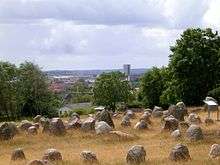
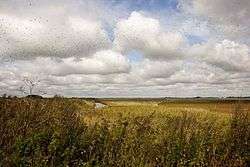
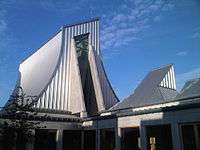
.jpg)
